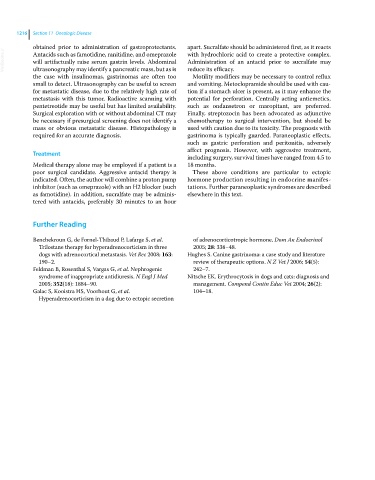Page 1278 - Clinical Small Animal Internal Medicine
P. 1278
1216 Section 11 Oncologic Disease
obtained prior to administration of gastroprotectants. apart. Sucralfate should be administered first, as it reacts
VetBooks.ir Antacids such as famotidine, ranitidine, and omeprazole with hydrochloric acid to create a protective complex.
Administration of an antacid prior to sucralfate may
will artifactually raise serum gastrin levels. Abdominal
ultrasonography may identify a pancreatic mass, but as is
Motility modifiers may be necessary to control reflux
the case with insulinomas, gastrinomas are often too reduce its efficacy.
small to detect. Ultrasonography can be useful to screen and vomiting. Metoclopramide should be used with cau-
for metastatic disease, due to the relatively high rate of tion if a stomach ulcer is present, as it may enhance the
metastasis with this tumor. Radioactive scanning with potential for perforation. Centrally acting antiemetics,
pentetreotide may be useful but has limited availability. such as ondansetron or maropitant, are preferred.
Surgical exploration with or without abdominal CT may Finally, streptozocin has been advocated as adjunctive
be necessary if presurgical screening does not identify a chemotherapy to surgical intervention, but should be
mass or obvious metastatic disease. Histopathology is used with caution due to its toxicity. The prognosis with
required for an accurate diagnosis. gastrinoma is typically guarded. Paraneoplastic effects,
such as gastric perforation and peritonitis, adversely
affect prognosis. However, with aggressive treatment,
Treatment
including surgery, survival times have ranged from 4.5 to
Medical therapy alone may be employed if a patient is a 18 months.
poor surgical candidate. Aggressive antacid therapy is These above conditions are particular to ectopic
indicated. Often, the author will combine a proton pump hormone production resulting in endocrine manifes-
inhibitor (such as omeprazole) with an H2 blocker (such tations. Further paraneoplastic syndromes are described
as famotidine). In addition, sucralfate may be adminis- elsewhere in this text.
tered with antacids, preferably 30 minutes to an hour
Further Reading
Benchekroun G, de Fornel‐Thibaud P, Lafarge S, et al. of adrenocorticotropic hormone. Dom An Endocrinol
Trilostane therapy for hyperadrenocorticism in three 2005; 28: 338–48.
dogs with adrenocortical metastasis. Vet Rec 2008; 163: Hughes S. Canine gastrinoma: a case study and literature
190–2. review of therapeutic options. N Z Vet J 2006; 54(5):
Feldman B, Rosenthal S, Vargas G, et al. Nephrogenic 242–7.
syndrome of inappropriate antidiuresis. N Engl J Med Nitsche EK. Erythrocytosis in dogs and cats: diagnosis and
2005; 352(18): 1884–90. management. Compend Contin Educ Vet 2004; 26(2):
Galac S, Kooistra HS, Voorhout G, et al. 104–18.
Hyperadrenocorticism in a dog due to ectopic secretion

